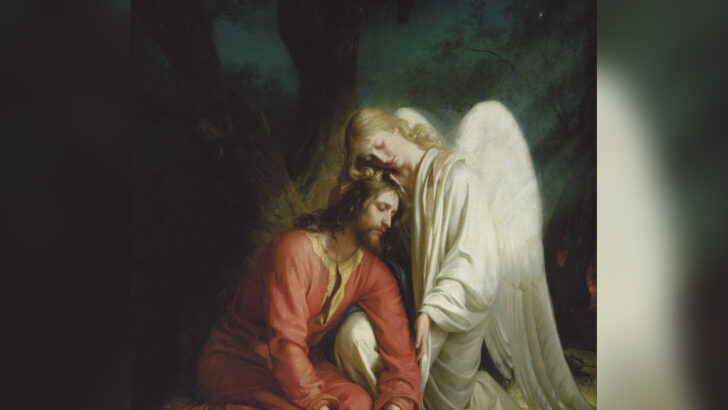We live this life “mourning and weeping in a valley of tears.” This was part of a prayer my parents prayed every day of their adult lives, as did many others in their generation. In the light of contemporary sensitivities (and one-sided spiritualities), this might sound morbid. Are we to understand our lives as time of grieving in a world that cannot deliver happiness? Is this really what God wants of us?
Taken without nuance, this can indeed be morbid. God didn’t put us into this world to suffer in order to go to Heaven. No. God is a good parent. Good parents bring children into this world with the intent that they should flourish and find happiness. So why might our Christian faith ask us to understand ourselves as mourning and weeping in a valley of tears?
Consolation
For my parents, that phrase brought a certain consolation, namely, that their lives didn’t have to deliver the full symphony, Heaven right now. It gave them sacred permission to accept that in life there will be disappointments, suffering, poverty, sickness, loss, frustrated dreams, heartbreak, misunderstanding and death. They never over-expected and understood that it is normal to experience pain and disappointment. Paradoxically, by accepting this limitation, they were able to give themselves permission to thoroughly enjoy life’s good moments without guilt.
For the most part spiritualities today do not leave sufficient space for grieving, a lacuna shared by most of the secular world”
My fear is that we are not equipping ourselves nor the next generation with the tools needed to undergo frustration, disappointment and heartbreak without breaking down in faith (and sometimes too in psyche and body). Today, for the most part, our normal expectation is that we shouldn’t be finding ourselves mourning and weeping, but rather that life should be delivering a full symphony. We no longer feel that we have sacred permission to be weeping.
The spirituality we breathe in today from our churches, theologians and spiritual writers has many strong points (just as the one my parents breathed in had its weaknesses). However, to my mind, for the most part spiritualities today do not leave sufficient space for grieving, a lacuna shared by most of the secular world.
We are not making enough space for grief, either in our churches or in our lives. We are not giving people the tools they need to handle frustration, loss, and heartbreak, nor how to grieve when they are beset by them. Outside of our funeral rituals, we make very little room for grief. Worse still, we tend to give the impression that there is something wrong in our lives if there are tears. What’s the place and value of grieving?
Accepting
First, as Karl Rahner poetically explains, it is a way of “accepting that in the torment of the insufficiency of everything attainable we ultimately learn that here in this life there is no finished symphony”. Grieving is also, as Rachel Naomi Remen writes, a critical way of self-care. Not to grieve, she submits, is a denial of our own wholeness. “People burn out because they don’t grieve”. British novelist Anita Brookner repeats a particular refrain in several of her books. Commenting on marriage, she suggests that “the first task in a marriage is for the couple to console each other for the fact that they cannot not disappoint each other.”
My parents had not read Karl Rahner, Rachel Noami Remen or Anita Brookner, but in their daily prayer they reminded themselves that in this life there is no finished symphony, that grieving is healthy self-care and that it’s consoling to accept that neither of them could ever be quite enough for the other since only God can provide that.
If Jesus wept, so must we. The disciple is never superior to the master”
What do we need to grieve? Our human condition and all that comes with it, namely, impermanence, the loss of our youth, the loss of a youthful body, wounds, betrayals, frustrated dreams, heartbreaks, the loss of loved ones, the death of our honeymoons, the perennial flow through our lives of people, places, and institutions and then disappearing, our incapacity to not be disappointing to others, the loss of our health and our eventual deaths. That’s what we need to grieve.
Grieve
And how do we grieve? Jesus left us a template for this when he grieved in the garden of Gethsemane. What did he do when, as the Gospels say, he was reduced to “sweating blood” as he faced his own imminent death? He prayed, prayed a prayer that openly and honestly expressed his agony, that recognised his distance from others inside this suffering, which acknowledged his own helplessness to do anything to change the situation, that repeatedly begged God to alter things, but that expressed a trust in God despite the present darkness. That’s the way Jesus wept.
If Jesus wept, so must we. The disciple is never superior to the master. Moreover, we can learn from Jesus that mourning and weeping in our lives do not necessarily mean that there is something wrong. It might well mean that this is where are meant to be.
We have sacred permission to sometimes be in agony.


 Fr Ronald Rolheiser
Fr Ronald Rolheiser Christ in Gethsemane by Carl Heinrich Bloch, 1880
Christ in Gethsemane by Carl Heinrich Bloch, 1880